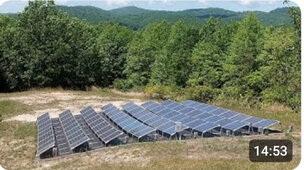jpwhit
New Member
I find it interesting that people are scared of HV batteries. High voltage DC isn't as dangerous as high voltage AC. Most everyone has HV PV inputs already in their system as well. If you're so scared of HV DC, then you should wire all your PV panels in parallel and have 30-50V coming into your MPPT inputs at really high amperage. But wait, everyone would say that's stupid and inefficient. Yet they turn around and do exactly the same thing with their batteries........
I know the answer above is you don't find inverters setup for MPPT inputs with that low of a voltage. But they did make inverters like that back in the early days. But nobody does now simply because it's inefficient. The same is true with battery inputs and it's only a matter of time before all inverters move to HV batteries for the increased efficiency.
12, 24, and 48V battery inverters exist because of the heritage of lead acid batteries in those voltages. Along with the desire to support battery / inverter setups where you didn't have to start with more than a few batteries because they tended to be large individually. Now that lead acid batteries are being replaced by newer battery technologies that naturally come in smaller cells, there is really no reason to continue with these limited voltages.
I've heard the argument that with DIYers it's safer to stay with low voltage because they can make more costly / dangerous mistakes with higher voltages, but I don't really buy that argument because almost nobody makes any of this equipment with DIYer's in mind. And if that argument were really true, you'd still have some inverter makers providing inverters with low voltage MPPT PV inputs.
I also hear the argument that HV BMS'es are hard to find. And there's a little truth to that, but that's also just a lack of experience with HV battery design as well. For example, I've studies or been involved of the design of EV battery systems from Tesla, GM, Ford, and others as part of my career being involved in the industrial / automotive / defense industry. None of the EV makers HV battery systems have a single monolithic BMS for the entire HV battery system. All of them consist of modules somewhere between 24 - 100V. They all follow the pattern of having a BMS system at each module level. And they typically do balancing of the cells in the scope of a module. And of course, they have a master BMS controller to understand the bigger picture. And that's probably the missing link for the DIY community.
That's because as long as the number of cells in each module is a high enough number of cells to statistically represent the typical behavior of the battery cells in aggregate, which is the case with 24v modules and Li-Ion or LFP cells, there isn't much of an improvement in the reliability of the system to balance cells beyond the module level. Said in another way, if the frequency where one module made of multiple cells gets out of balance with another module of the same design is really tiny. Then it's not worth spending any money to handle that case. If that happens statistically 1 in 100,000 battery systems. It just makes more sense to have the 1 in 100,000 battery system shut itself down as "failed". Cases where a module gets out of balance with another modules because one of the cells is simply failing doesn't really matter. Because typically balancing can't really save a battery system in that case anyway.
It's not a safety issue as long as the BMS in each module has the ability to signal system shutdown if an error occurs in the sub-system. And that signaling almost always happens via the CANBUS communications.
I know the answer above is you don't find inverters setup for MPPT inputs with that low of a voltage. But they did make inverters like that back in the early days. But nobody does now simply because it's inefficient. The same is true with battery inputs and it's only a matter of time before all inverters move to HV batteries for the increased efficiency.
12, 24, and 48V battery inverters exist because of the heritage of lead acid batteries in those voltages. Along with the desire to support battery / inverter setups where you didn't have to start with more than a few batteries because they tended to be large individually. Now that lead acid batteries are being replaced by newer battery technologies that naturally come in smaller cells, there is really no reason to continue with these limited voltages.
I've heard the argument that with DIYers it's safer to stay with low voltage because they can make more costly / dangerous mistakes with higher voltages, but I don't really buy that argument because almost nobody makes any of this equipment with DIYer's in mind. And if that argument were really true, you'd still have some inverter makers providing inverters with low voltage MPPT PV inputs.
I also hear the argument that HV BMS'es are hard to find. And there's a little truth to that, but that's also just a lack of experience with HV battery design as well. For example, I've studies or been involved of the design of EV battery systems from Tesla, GM, Ford, and others as part of my career being involved in the industrial / automotive / defense industry. None of the EV makers HV battery systems have a single monolithic BMS for the entire HV battery system. All of them consist of modules somewhere between 24 - 100V. They all follow the pattern of having a BMS system at each module level. And they typically do balancing of the cells in the scope of a module. And of course, they have a master BMS controller to understand the bigger picture. And that's probably the missing link for the DIY community.
That's because as long as the number of cells in each module is a high enough number of cells to statistically represent the typical behavior of the battery cells in aggregate, which is the case with 24v modules and Li-Ion or LFP cells, there isn't much of an improvement in the reliability of the system to balance cells beyond the module level. Said in another way, if the frequency where one module made of multiple cells gets out of balance with another module of the same design is really tiny. Then it's not worth spending any money to handle that case. If that happens statistically 1 in 100,000 battery systems. It just makes more sense to have the 1 in 100,000 battery system shut itself down as "failed". Cases where a module gets out of balance with another modules because one of the cells is simply failing doesn't really matter. Because typically balancing can't really save a battery system in that case anyway.
It's not a safety issue as long as the BMS in each module has the ability to signal system shutdown if an error occurs in the sub-system. And that signaling almost always happens via the CANBUS communications.




